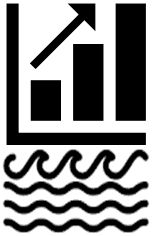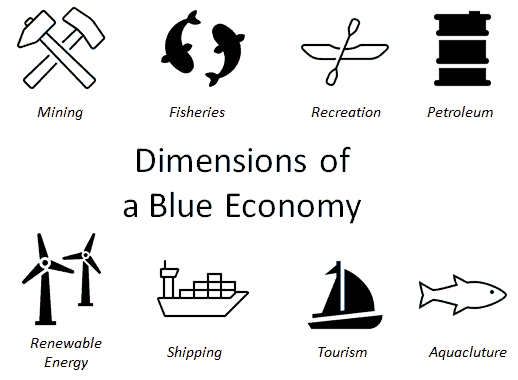The Blue Economy:
Converging on the Waves
 |
Hari Srinivas |
|
Policy Analysis Series E-183. November 2022
|

|
|
 The Blue Economy is a term that is used to describe the ways that the oceans, coasts, and all its resources can be seen as assets with an economic value. The idea behind a blue Economy is that, if we look at all of the resources in our oceans and coastal areas in a different way than we have in the past, we can create industries and businesses that not only support local communities, but also help ease the pressure on the global emvironment and risks from natural disasters. The Blue Economy is a term that is used to describe the ways that the oceans, coasts, and all its resources can be seen as assets with an economic value. The idea behind a blue Economy is that, if we look at all of the resources in our oceans and coastal areas in a different way than we have in the past, we can create industries and businesses that not only support local communities, but also help ease the pressure on the global emvironment and risks from natural disasters.
According to Will Jones from The Guardian, who wrote about this topic recently: The idea of a Blue Economy Ewhere coastal communities build upon their natural assets to become hubs for aquaculture, marine tourism and other ocean-based industries Ehas been around for some time.E
Who is Working on a blue Economy?
There are many people who are actively working on creating a blue Economy. Many coastal communities are working to make their waterfronts more attractive and accessible to tourists. As a result, these coastal areas and are becoming hotspots for tourism, which has benefited the local economy.
Other examples of people who are working on a blue Economy include people in research and development who are looking for new ways to use the ocean and coastal waters for better habitat conservation for marine life, aquaculture, or sustainable energy production.
Why a blue Economy Matters
a blue Economy matters because it is an opportunity to create jobs, increase revenue, and improve the quality of life along coastal areas. If we look at the ocean and coastal areas from a sustainability perpectve, we can not only create opportunities for business start-upss, that use the ocean as a source of goods, but also as a source of energy and other activities.
In addition to creating new jobs, a Blue Economy can also help to protect and preserve the environment. For instance, by making use of coastal areas for aquaculture (or fish farming), we can reduce the amount of pollution from commercial fishing. Similarly, by using the ocean for renewable energy, we can reduce carbon dioxide in the atmosphere.
Also, involving local communities to create jobs in coastal habitat preservation of mangroves, seagrass and coral reefs help in a number of ways - carbon storage, marine nursaries and habitats, coastal protection and erosion prevention, water purification and sediment/pollutant traps, and tourism.
What Can Be Part of a Blue Economy?
There are several industries that can be part of a Blue Economy, including marine tourism, sustainable energy production, sustainable fishing, undersea mining, and aquaculture. Sustainable fishing is a great example of how a Blue Economy can be beneficial to both the environment and people.
 |
- Jobs: Fishing, aquaculture, seaside and marine tourism employ over 350 million people worldwide [UN FAO].
- Food: Fish accounts for about 15.7% of the global consumption of animal protein. Of this, more than half is provided by aquaculture. [UNESCO]
- Assets: The value of ocean-related assets is estimated at more than USD 2.5 trillion (About the size of UK's economy) [WWF]
- Transport: Over 90% of the worlds traded goods travel by sea.
- Energy: Offshore wind energy generation capacity is estimated to grow to more than 300GW by 2040
|
By making use of fish farming and other aquaculture activities, we can reduce the amount of fish that is caught in the wild. By doing this, we can also reduce the amount of pollution and and biodiversity losses that are affecting global fish populations. Similarly, sustainable aquaculture can be used to grow shellfish, as well as seaweed and other sea plants.
How does a Blue Economy Helps Environment and Humans?
A Blue Economy can be helpful to the environment in several ways. As mentioned above, aquaculture can reduce the amount of pollution from commercial fishing. Sustainable energy production (through wind and tidal wave energy generators) can help to reduce emission of carbon dioxide in the atmosphere.
When we look at a Blue Economy from the perspective of humans, we see that the ocean is a vast resource that is largely untapped. This means that there is great potential for building new industries, creating new jobs, and increasing local revenue, supporting local coastal communities and their economies.
Activities and Industries Associated with a Blue Economy
|
Type of Activity
|
Ocean Service
|
Industry
|
Drivers of Growth
|
|
Harvest of living
resources
|
Seafood
|
Fisheries
|
Food Security
|
|
Aquaculture
|
Demand for Protein
|
|
Marine biotechnology
|
Pharmaceuticals, chemicals
|
R&D for healthcare and
industry
|
|
Extraction of non
living resources,
generation of new
resources
|
Minerals
|
Seabed mining
|
Demand for minerals
|
|
Energy
|
Oil and gas
|
Demand for alternative
energy sources
|
|
Renewables
|
|
Fresh water
|
Desalination
|
Demand for fresh water
|
|
Commerce and
trade in and around
the oceans
|
Transport and trade
|
Shipping
|
Growth in seaborne trade;
International regulations
|
|
Port infrastructure and services
|
|
Tourism and recreation
|
Tourism
|
Growth of global tourism
|
|
Coastal Development
|
Coastal urbanization
|
|
Domestic regulations
|
|
Response to ocean
health challenges
|
Ocean monitoring and
surveillance
|
Technology and R&D
|
R&D in ocean technologies
|
|
Carbon Sequestration
|
Blue Carbon
|
Growth in coastal and
ocean protection and
conservation activities
|
|
Coastal Protection
|
Habitat protection and
restoration
|
|
Waste Disposal
|
Assimilation of nutrients and wastes
|
Technology
development
|
Problems with a Blue Economy
There are several potential issues with a Blue Economy - the first being that it is not a solution to all problems associated with oceans, coasts and small islands. Coastal communities face low financial security, particularly low-income households who face the twin challenge of poverty as well as hightened risks from natural disasters.
Another potential issue with a Blue Economy is that people tend to overestimate the size of the ocean economy. This is understandable, given that the ocean is a vast resource that has largely been untapped. However, this can also lead to unrealistic expectations. Finally, there can be issues with promoting the industries and facilitating the drivers of growth (listed in the table above) to achieve the vision of a Blue Economy.
A Blue Economy is an opportunity to create jobs, increase revenue, and improve the quality of life along coastal areas. The challenges of managing oceans - as they are located beyonf the jurisdiction of national marine boundaries - are also challenges that hinder the operationalization of a Blue Economy. But the opportunities outweigh the challenges, particularly when a Blue Economy's activities also help in preserving ocean environments and conserving its assets/resources. The SDGs, specifically SDG 14 - Life Below Water, will help us develop policies that wil matain the environmental goals while taking advantage of theconomic opportunities of the oceans.
|
|
|